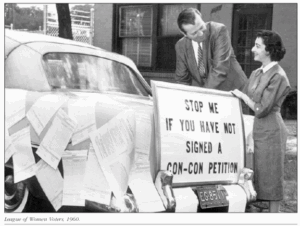League History
On November 5, 1918, Michigan voters provided women of their state with total suffrage. The suffrage cause had been a long and hard battle. Passage of the suffrage amendment set the stage for the creation of the citizen-oriented League of Women Voters. The suffrage movement moved into its next phase – its plan to improve the electorate by providing citizen education and informing voters of their choices.
On April 4, 1919, at the 33rd convention of the Michigan Equal Suffrage Association held in Grand Rapids, the members voted to become the Michigan League of Women Voters, an organization for women only. Belle Brotherton of Detroit was elected as its first president. The name change occurred barely one week after Carrie Catt Chapman, the President of the National American Women’s Suffrage Association, called for the formation of such organizations. Chapman proposed creation of a League to continue the work of the suffrage organizations whose purpose would be to create an educated electorate.
From their roots in suffrage organizations, early League leaders learned the advantages of letter writing as a means of swaying legislative action. League members used this technique to encourage Michigan legislators to be among the first to ratify the suffrage amendment to the US Constitution. Michigan joined Illinois and Wisconsin as the first three states to ratify the 19th Amendment.
Once the National League of Women Voters officially organized in February, 1920, existing state Leagues of Women Voters like Michigan’s affiliated under its leadership. By establishing a national organization, Carrie Catt Chapman was determined to create “a living memorial dedicated to the memory of our departed leaders and the sacrifices they made for our cause” and “to assist women in making decisions which would make the nation safer for their children and their children’s children.”
In addition to citizen education efforts, early League members began to press for government reforms in voter registration, taxation, civil service, and laws effecting children. Positions taken by the League were always based upon careful research followed by discussion and consensus on what the membership believed needed to be accomplished. Once positions were approved, the League followed up with educational programs and lobbying efforts. Major issues in which the League of Women Voters achieved some success during the first 25 years included civil service reform, election law reform and legislation concerning children’s welfare. In 1941, thanks in part to the League’s lobbying efforts, Michigan law was amended to forbid factory work by those under 16 and to mandate school attendance by all children between the ages of seven and sixteen.
In 1947, after the National League of Women Voters changed its name to the League of Women Voters of the United States, the Michigan League changed its name to the League of Women Voters of Michigan.
One element that was carried over from the League’s origin with the National American Women’s Suffrage Association was the League’s commitment to non-partisanship. League founders believed that maintaining a nonpartisan stance would protect the fledgling organization from becoming mired in the party politics of the day. This policy continues to exist within the organization. The League is proud to be nonpartisan, neither supporting nor opposing candidates or political parties at any level of government, but always working on vital issues of concern to members and the public. The League has a long, rich history,that continues with each passing year.
Excerpted from: A Powerful Voice for 75 Years. The League of Women Voters in Michigan: Its History. By Diane M. Rockall, 1995
 The next two were approved in 1850 and 1908. The current constitution was approved by voters in 1963. Click here to see the Convention delegates who generated the 4 constitutions. The Michigan Constitutional Convention of 1961-62 was a pivotal event that resulted in the current Michigan Constitution, significantly revising the state’s governance and civil rights protections. The League of Women Voters of Michigan was instrumental in getting the “Con Con” proposal passed in 1961 and in getting the Constitution approved by voters in 1963. For more information about the 1961-62 Constitutional Convention, read Michigan’s Con Con 11 by Lynn Liberato which highlights the contributions of the first female delegate, some of whom were League of Women Voters members.
The next two were approved in 1850 and 1908. The current constitution was approved by voters in 1963. Click here to see the Convention delegates who generated the 4 constitutions. The Michigan Constitutional Convention of 1961-62 was a pivotal event that resulted in the current Michigan Constitution, significantly revising the state’s governance and civil rights protections. The League of Women Voters of Michigan was instrumental in getting the “Con Con” proposal passed in 1961 and in getting the Constitution approved by voters in 1963. For more information about the 1961-62 Constitutional Convention, read Michigan’s Con Con 11 by Lynn Liberato which highlights the contributions of the first female delegate, some of whom were League of Women Voters members.